How Our LLC Program Fosters Reading Culture
Fostering reading culture in the school is one of the most important elements of an LLC program. Some of the current ways that our LLC promotes reading culture is through orientations. We believe that getting students familiarized with the collection, facilities and digital tools, the more confident and comfortable students become with accessing library services. Orientations start with grade 8s in September, with a spring refresher. Some activities included in orientations are: information presentations, scavenger hunts around the LLC and read-ins.
Read-ins have proven to be very popular with students. It is a pre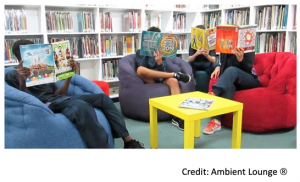 -arranged reading time booked through English classes, where the entire class comes into the LLC and chooses a book, beanbag cushion and students are given a snack as they read (the only time we permit food in the LLC and students love it!).
-arranged reading time booked through English classes, where the entire class comes into the LLC and chooses a book, beanbag cushion and students are given a snack as they read (the only time we permit food in the LLC and students love it!).
We also promote reading culture through physical displays, promoting new collection acquisitions to staff/students. We feel that it’s important for the community to connect with the LLC and feel a sense of ownership. We take book suggestions from both staff and students and have regular ‘You asked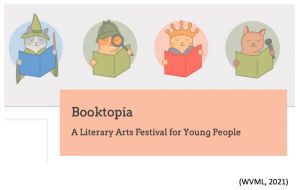 for it’ displays that show new books purchased from community suggestions. Book contests, visiting authors, and Booktopia, which is run by our local community library in connection with our school district are important to the LLC program and fostering reading culture. We also feel teachers are integral in helping to foster reading culture. We regularly try to collaborate with classroom teachers and prior to COVID, we would run a few library lunch socials for staff, where resources would be on display and snacks provided. These always had a great turnout and helped to build connections with classroom teachers.
for it’ displays that show new books purchased from community suggestions. Book contests, visiting authors, and Booktopia, which is run by our local community library in connection with our school district are important to the LLC program and fostering reading culture. We also feel teachers are integral in helping to foster reading culture. We regularly try to collaborate with classroom teachers and prior to COVID, we would run a few library lunch socials for staff, where resources would be on display and snacks provided. These always had a great turnout and helped to build connections with classroom teachers.
As I reflect on how we foster reading culture, I wonder how technology plays a role? We support curriculum with technology. Our VR goggles, 3D Printers, IPads, Kindles, etc are a part of our makerspace for lending and we use much of this equipment to support curriculum and research projects, but I can’t help but wonder if we used social media more actively to foster reading culture, would our audience reach be broader? Can we strategically use social media and create engagement to promote reading culture?
What about Social Media?
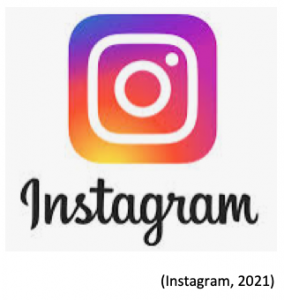
 In Lindsay Barrett’s, 25 Ways to Build Your School’s Reading Culture, she explores the idea of tapping into social media through Instagram, Twitter and Snapchat to foster reading programs. She discusses that using these mediums help “to get kids excited about reading and connect with the wider community.” Some practical ways of doing this can be through creating hashtags, creating fake profiles for book characters and familiarizing students with platforms like Goodreads to motivate students (Barrett, 2019). Other social media activities like using Instagram to book talk digitally or Twitter for summaries and book reviews are suggestions by Kylie Gray in How I Use Instagram, Twitter & Snapchat to Turn My Students Into Readers (Gray, 2017).
In Lindsay Barrett’s, 25 Ways to Build Your School’s Reading Culture, she explores the idea of tapping into social media through Instagram, Twitter and Snapchat to foster reading programs. She discusses that using these mediums help “to get kids excited about reading and connect with the wider community.” Some practical ways of doing this can be through creating hashtags, creating fake profiles for book characters and familiarizing students with platforms like Goodreads to motivate students (Barrett, 2019). Other social media activities like using Instagram to book talk digitally or Twitter for summaries and book reviews are suggestions by Kylie Gray in How I Use Instagram, Twitter & Snapchat to Turn My Students Into Readers (Gray, 2017).
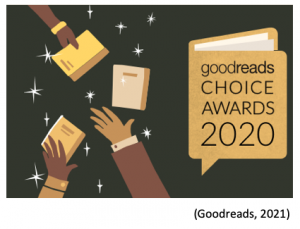 Doug Johnson also suggests Goodreads, LibraryThing and Biblionasium, which are alternatives to traditional weekly book club meeting. These are sites readers can share and discover more about books. He also notes that for TLs that are wanting “a walled-garden program that allows sharing, library automation programs like Follett’s Destiny Quest allow students to record what they’ve read, write recommendations, share their recommendations with other students and discuss books online” (Johnson, 2019). He also expands on social media sharing can go beyond sharing reading interests to include curation tools like Tumblr, Pinterest, and Scoop.it. Some of these sharing sites, I am familiar with but others like Scoop.it, LibraryThing and Biblionasium are new to me and require more investigation. Another TL that I have worked with designed a unit with to have orientation students select books and submit reviews through Follett Destiny Quest and this seemed to be well-liked by students as they were able to find peer feedback on books.
Doug Johnson also suggests Goodreads, LibraryThing and Biblionasium, which are alternatives to traditional weekly book club meeting. These are sites readers can share and discover more about books. He also notes that for TLs that are wanting “a walled-garden program that allows sharing, library automation programs like Follett’s Destiny Quest allow students to record what they’ve read, write recommendations, share their recommendations with other students and discuss books online” (Johnson, 2019). He also expands on social media sharing can go beyond sharing reading interests to include curation tools like Tumblr, Pinterest, and Scoop.it. Some of these sharing sites, I am familiar with but others like Scoop.it, LibraryThing and Biblionasium are new to me and require more investigation. Another TL that I have worked with designed a unit with to have orientation students select books and submit reviews through Follett Destiny Quest and this seemed to be well-liked by students as they were able to find peer feedback on books.
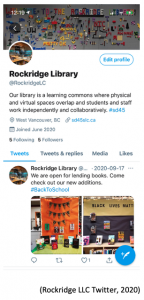
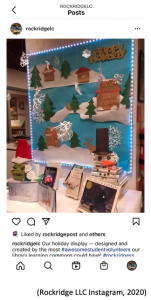 We have a Twitter and Instagram LLC site, but it is new and needs more regular updates. The blog topic, Instagram Social Media Reboot for School Libraries, Hannah Byrd mentions all of the various LLC promotional things that Instagram can do: “including tagging your location, mentioning another Instagram account like an author or bookstore, adding a hashtag, creating a poll, a question, quiz or a countdown” (Byrd, 2019). The purpose of using Instagram she reiterates is to create community engagement. She also mentions how she had to evolve with social media as its trends and community changes. She went from Myspace to Facebook to Twitter to Instagram to Snapchat and back to Instagram again. The visual nature of Instagram she feels appeals most to her school community. Her article also provides ideas of how to make Instagram a part of your promotional strategy.
We have a Twitter and Instagram LLC site, but it is new and needs more regular updates. The blog topic, Instagram Social Media Reboot for School Libraries, Hannah Byrd mentions all of the various LLC promotional things that Instagram can do: “including tagging your location, mentioning another Instagram account like an author or bookstore, adding a hashtag, creating a poll, a question, quiz or a countdown” (Byrd, 2019). The purpose of using Instagram she reiterates is to create community engagement. She also mentions how she had to evolve with social media as its trends and community changes. She went from Myspace to Facebook to Twitter to Instagram to Snapchat and back to Instagram again. The visual nature of Instagram she feels appeals most to her school community. Her article also provides ideas of how to make Instagram a part of your promotional strategy.
Future Goals
One of my goals this year is to build our social media presence. I am going to focus on Instagram and share to Twitter. I think weekly posts would make the most sense, but I know in the past I have also used Hootsuite for film promotion and perhaps there is a way I can preload in some future posts to keep social media momentum up.
Works Cited:
Barrett, Lindsay. 2019. 25 Ways to Build your Schools Reading Culture. Retrieved from https://www.weareteachers.com/build-reading-culture/
Byrd, Hannah. 2019. Instagram Social Media Reboot for School Libraries. Retrieved from https://knowledgequest.aasl.org/instagram-social-media-reboot-for-school-libraries/
Goodreads. 2021. [Image]. Retrieved from https://www.goodreads.com/
Gray, K. 2017. How I Use Instagram, Twitter & Snapchat to Turn My Students Into Readers. Retrieved from https://www.weareteachers.com/social-media-activities-for-ela/
Instagram. 2021. [Image]. Retrieved from https://www.instagram.com/
Johnson, Doug. 2019. 10 Ways to Use Technology to Promote Reading. Retrieved from https://www.eschoolnews.com/2019/05/14/10-ways-to-use-technology-to-promote-reading/
Rockridge Library Learning Commons Twitter. 2020. Retrieved from @rockridgeLC
Rockridge Library Learning Commons Instagram. 2020. Retrieved from @rockridgelc
Twitter. 2021. [Image]. Retrieved from https://twitter.com/
West Vancouver Memorial Library. 2021 [Image]. Retrieved from https://westvanlibrary.ca/kids-teens/booktopia/

 Follow
Follow
I truly enjoyed reading about some of the initiatives that your LLC puts forth to encourage students to read. We also have something like Read-Ins but I don’t think they are as fun as they are not allowed to eat in our space. Your inquiry into Social Media to foster reading programs is very interesting. My library is thinking about getting an Instagram account and a Twitter account and featuring books so that the students know what books (new or old) have in the library. The resources that you mentioned will help me and the TLs justify the want to use Social Media to do this too, especially Kylie Gray’s article. Thanks!
Well done blog post on some great tools and approaches to build up the buzz and excitement around reading and your library program. This was a dense collection of tools, resources, guides and best practices on implementing and utilizing social networks to share the good books and encourage more students to read. I appreciated the discussion of how you engage and entice students and staff into your space, provide small snacks and comfy spots, as well as great books and have seen strong results. A good plan for going forward to continue to build upon your success and expand your social media presence.
I enjoyed reading your blog post it sounds like your school does a lot to promote their library. I am an elementary classroom teacher, so reading about a high school LLC was interesting. My oldest daughter is in grade 9 this year and while she’s a great reader and writer, she does not go into the school library unless she is made to. I think that using apps, like Instagram is a smart way to go. Apps like Twitter and Facebook don’t appeal to her or her friends, but her dance teacher last year posted to Instagram and those posts, she was happy to view.
Yes this is the feedback we are getting too. Instagram seems like the best route for library. We will have a Twitter account but likely share from Instagram to it. I think the part that I struggle with, is how do I make visual content go beyond just book displays or new books. We don’t share images of people and I wonder what other dynamic choices we can use. I was looking up today the legalities of meme use, and I’ve seen some great use of them with public libraries. Just wanted to know the risks.
These are some great guidelines and suggestions for building up a professional social media presence. One suggestion I would add to this conversation is a recommendation to seek out your school policy around social media use for employees. I know in my school division I have been reminded many times that it is recommended that we should not have social media accounts that use our real names or mentions our school/school division because everything posted on the internet is seen as making a public statement which can only happen with the approval of the division. For practical purposes, and what I notice around me, this is not being followed and many of my colleagues, including myself still have social media. In fact, I’m not sure they are legally allowed to tell me that I can’t. However, every time I post, like or retweet I am aware that what I have said could be used against me and that my superintendent, who is on Twitter, may see what I have endorsed. This complicates things to say the least and has changed my relationship and enjoyment when it comes to using social media. I tend to not comment on education-related items unless they are content focused (ex: great book titles for Black History Month).